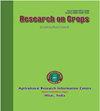伏尔加格勒干旱区冬小麦(Triticum aestivum L.)生物和化学植保方法对病害和产量的影响比较
Q3 Agricultural and Biological Sciences
引用次数: 1
摘要
伏尔加格勒地区是冬小麦主产区,播种面积超过100万公顷。提高冬小麦产量的问题是相关的。解决这个问题最有效的方法是使用化学和生物制剂进行种子处理和叶面喂养。2019年至2021年,在RAN联邦农业生态学研究中心(俄罗斯,伏尔加格勒)的试验场进行了科学研究。土壤为浅栗色、solonetz和重壤土。采用生物化学方法对下伏尔加地区干旱草原区冬小麦Kamyshanka4在休耕轮作中的作物保护进行了研究。本研究的目的是开发冬小麦植物保护的生物和化学方法,考虑品种和地带特征,以提高产量和种子质量。新颖之处在于,首次在下伏尔加地区干旱草原区的育种实验室条件下,研究了生物和化学保护方法对冬小麦作物的有效性,并对所研究的农艺方法进行了经济评价。对下伏尔加地区浅栗色土壤在雨养条件下冬小麦保护方法的研究表明,作物产量提高了27.5%,植物检疫状况改善了48.1%,与对照变体(b/o)相比,采用生物保护方法(BSCа-3 2.0 l/ha+腐殖酸钾1.0 l/t(谷物处理)+BSCа3 2.0 l/ha(营养处理))的变体的盈利能力增加。生物特征指标、产量结构元素和产量的最小值是通过使用化学保护手段获得的。本文章由计算机程序翻译,如有差异,请以英文原文为准。
Comparative effect of biological and chemical methods of plant protection of winter wheat (Triticum aestivum L.) on diseases and yield in the arid zone of Volgograd region
Volgograd region is a large winter wheat production region, where it is sown on more than one million hectares. The issues of increasing the yield of winter wheat grain are relevant. The most effective method for solving this problem is the use of chemical and biological preparations for seed treatment and foliar feeding. Scientific research was carried out in the experimental field of the Federal Research Center of Agroecology RAN from 2019 to 2021 (Russia, Volgograd). The soil is light chestnut, solonetz and heavy loam. Biological and chemical methods of winter wheat Kamyshanka 4 crop protection in cereal fallow rotation in the dry steppe zone of the Lower Volga region were used in the experiment. The aim of the research was to develop biological and chemical methods of plant protection of winter wheat, taking into account the varietal and zonal characteristics to increase the yield and seed quality. The novelty is that for the first time in the conditions of the dry steppe zone of the Lower Volga region in the laboratory of breeding, seed production and nursery production of the Federal Scientific Center of Agroecology RAN the effectiveness of biological and chemical methods of protection on winter wheat crops was studied and the economic assessment of the studied agronomic methods was given. The investigation of the studied methods of winter wheat protection in rainfed conditions on light chestnut soils of the Lower Volga region revealed an increase of the crop capacity by 27.5%, an improvement of the phytosanitary state of the crops by 48.1%, an increase of the profitability in the variants with biological protection methods (BSCа-3 2.0 l/ha+potassium humate 1.0 l/t (grain treatment)+BSCа-3 2.0 l/ha (vegetative treatment)) compared to the control variant (b/o). Minimum values of biometric indicators, elements of yield structure and yield were obtained with the use of chemical means of protection.
求助全文
通过发布文献求助,成功后即可免费获取论文全文。
去求助
来源期刊

Research on Crops
Agricultural and Biological Sciences-Soil Science
CiteScore
1.50
自引率
0.00%
发文量
93
审稿时长
1 months
期刊介绍:
The Research on Crops is a peer-reviewed journal publishing original research papers, review articles and short communications in English on all basic and applied aspects of crop sciences, agricultural water management, agro-climatology, agroforestry, agronomy, crop production, crop protection, cropping systems, food science & technology, genetics & plant breeding, horticulture, plant & soil science, plant biotechnology, plant nutrition, post-harvest management of crops, seed science, soil management & tillage, vegetables, weed science, agricultural engineering, agri-business, agricultural economics and extension, etc. The aim of the journal is to provide a forum for the scientific community to publish their latest research findings.
The manuscripts submitted for publication should not contain data older than 4 years on the date of submission.
The articles submitted for publication in this journal should not be submitted elsewhere simultaneously for publication in another journal. These should not carry any copyright material without prior permission of copyright holder.
The articles should present a complete picture of the investigation made and should not be split into parts.
There is no prescribed limit regarding the number of pages in case of full-length articles. However, the authors are advised to keep the length of their articles from 4 to 10 full printed pages of the journal.
The articles should be divided into the sub-sections: ABSTRACT, INTRODUCTION, MATERIALS AND METHODS, RESULTS AND DISCUSSION, CONCLUSIONS, and REFERENCES. Tables and figures should be appended separately at the end.
 求助内容:
求助内容: 应助结果提醒方式:
应助结果提醒方式:


